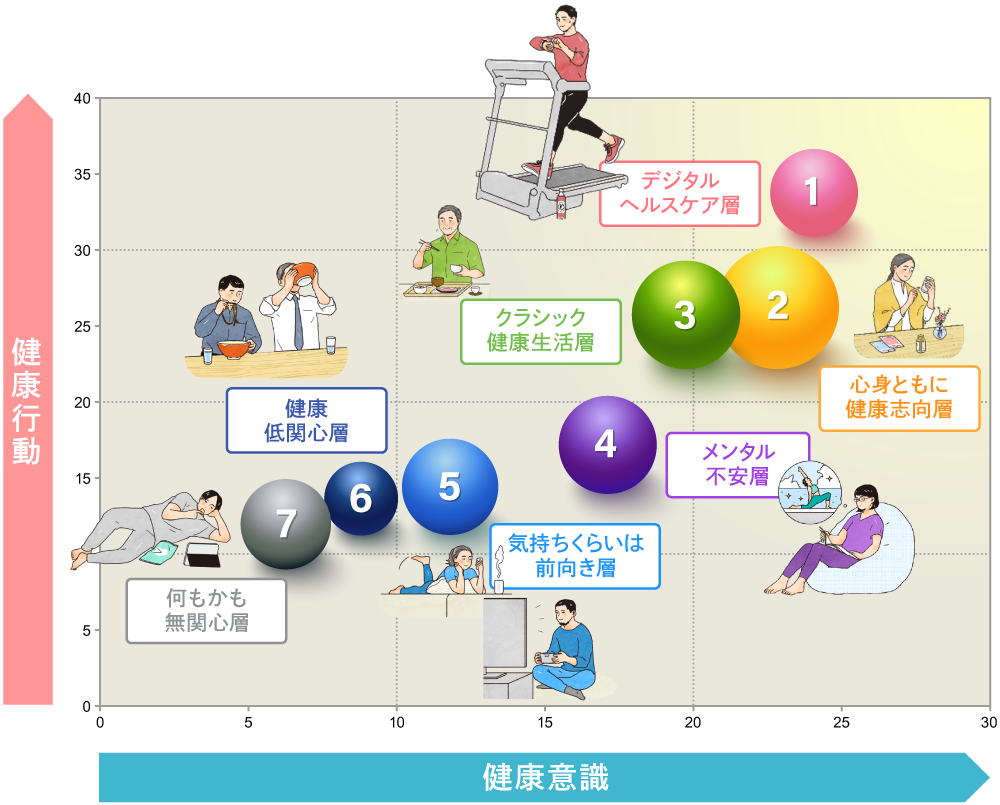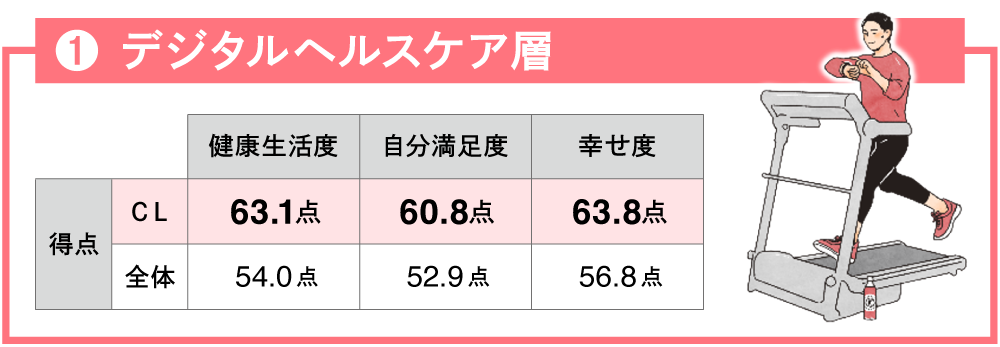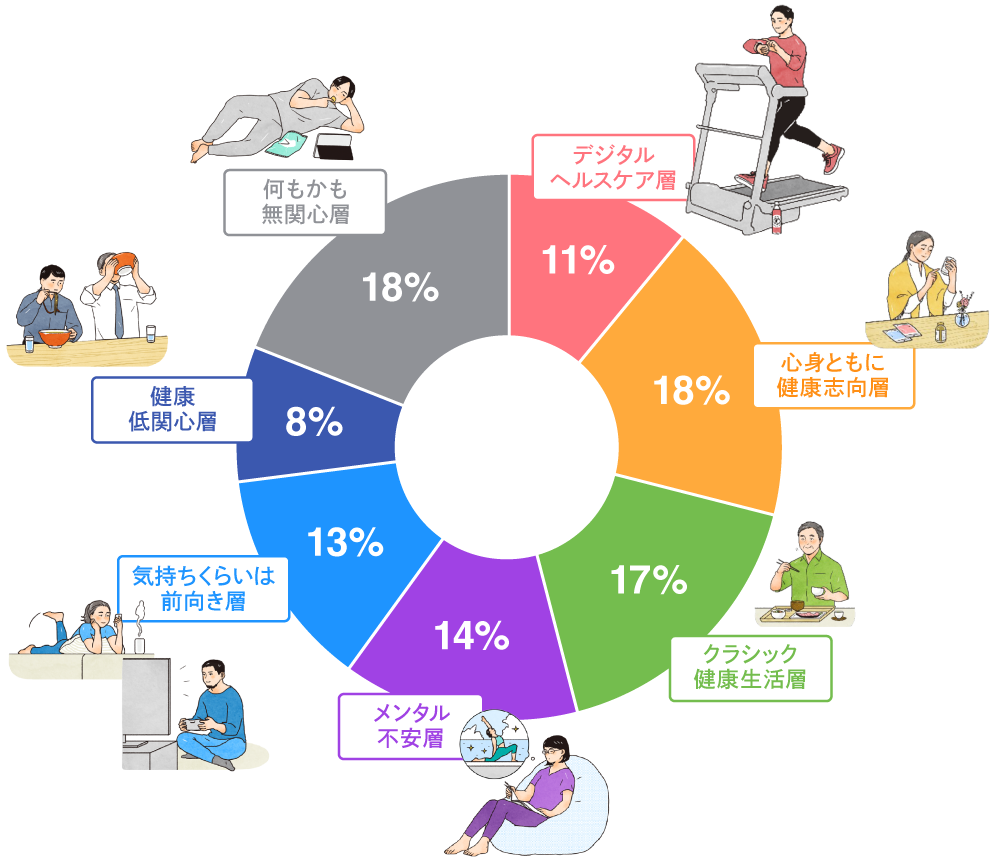"We want to create a program that even people with low health awareness will find interesting!"
"We want to design this service prioritizing health-conscious individuals first."
These are common conversations in healthcare marketing to define target personas. But isn't it challenging to grasp insights about what "high" or "low" health consciousness actually means?
The "Wellness 10,000 Survey" conducted by Dentsu Inc. Healthcare Team uses approximately 130 health awareness and health behavior items as factors to classify consumers into seven distinct types through cluster analysis. This reveals more specific characteristics that go beyond the simple dichotomy of high or low health awareness. This time, we present findings from the "17th Wellness 10,000 Survey 2023" ( survey overview here ). What characteristics do you want your healthcare business to target?
Overview and Occurrence Rate of Healthcare Clusters
First, let's look at the overall picture of the 7 types. The chart below plots the average response scores for health awareness and health behavior on the horizontal and vertical axes. In other words, clusters positioned higher on the right correspond to what we would call "highly health-conscious individuals."
The three layers generally perceived as "high health awareness" are: ① Digital Healthcare Layer, ② Holistic Health-Oriented Layer, and ③ Classic Healthy Lifestyle Layer. Conversely, the other four layers are likely perceived as having "low health awareness."

Each cluster appears in the following proportions.
Even among the highly health-conscious, there are types who don't exercise!?
Now, let's introduce the characteristics of each cluster. First, the three segments considered "highly health-conscious."

The Digital Healthcare Segment is the group most responsive to "health tech," which is gaining recognition in the Japanese market. They manage their health using data and show significant interest in cutting-edge technologies like genetic testing.
They enjoy the act of managing their health and have integrated it into their lifestyle. As a group that also wants to understand things logically (left-brain thinking), they are less easily persuaded by image-based appeals alone. Academic backgrounds and evidence become essential elements in the narrative needed to drive behavioral change. Furthermore, they are not just consumers of information; they also actively share their health activities on social media.

The Health-Conscious Mind and Body group places particular importance on experiencing "well-being" and has a strong desire to maintain mental stability. They spend the most on health products like supplements among all clusters. Despite being the top performers with high health awareness and actions across the board, their defining characteristic is that they are the least active when it comes to "exercise." As this cluster has a high proportion of women, it also has strong affinity with beauty contexts and approaches centered on mindful living.

The Classic Healthy Living group has a high proportion of people in their 60s and actively engages in accessible health behaviors. They report the highest happiness level over the past year among all clusters and have a strong self-assessment of leading a healthy life. From an age perspective, they are the group most directly concerned with lifestyle diseases and aging countermeasures. However, they actually experience few troubling symptoms and are the type who prefer not to rely on specific health foods or supplements. This group is likely to respond well to health behaviors designed to be easily incorporated into daily life.
Even within clusters with low health awareness, the reasons are polar opposites!?
Next, the characteristics of the three clusters considered to have low health awareness.
*The "Indifferent to Everything" group shows no interest in any category and is excluded here.
The Mental Anxiety Group's most significant characteristic is that while they intellectually believe "I should/want to do XX for my health," their actions don't follow through. Their health literacy isn't particularly high either. With low self-esteem and a large gap between their perceived ideal self and reality, they seem to prefer contexts focused on stress relief and mental care.
The "At Least Feel Positive" group, in contrast to the Mental Anxiety group, has lower health aspirations ("should be like this") and tends to be satisfied with current actions and their results. Despite having below-average health lifestyle scores, this group has high happiness and self-satisfaction levels.
A defining characteristic is their presence across all genders and age groups. For this group, the purpose of health actions should be set not on "eliminating negatives," but on making daily life more positive, such as "feeling good" or "relaxing."
The Low Health Interest Group focuses primarily on eating three meals a day but shows little interest in health beyond that. They generally avoid seeking out healthy products themselves. However, they can potentially be reached by creating opportunities for "just in case" or impulse purchases along their usual paths (e.g., near their workplace). Additionally, depending on the health theme, encouragement from family or others around them may be more effective than their own motivation.
As seen above, analyzing the market through cluster analysis reveals that even within high- and low-health-consciousness groups, distinct types exist.
For example, the "Mind-Body Health-Oriented Segment" is a highly health-conscious target. However, simply appealing to them with "Exercise for your health!" is unlikely to change their behavior. Over 90% of this segment understands that "exercise is important." Yet, the reason they don't do it isn't due to insufficient information, low understanding, or lack of money. It's because it doesn't align with the values, lifestyle, or preferences they prioritize.
Even highly health-conscious individuals likely have other aspects to their lives—perhaps they enjoy drinking with colleagues or friends, or watching movies late at night. Such activities can feel more human and enjoyable.
Fundamentally, very few people prioritize "health" above all else in their lives. For those of us working in the healthcare market, it's crucial not to ignore these "true feelings" of people. The key to getting people to take health actions and stick with them seems to lie in broadening our perspective to imagine the whole lifestyle and way of life behind Target Person A's level of health consciousness – what values and lifestyle might underlie it?
[Survey Overview]
Survey Name: 17th Annual "Wellness 10,000-Person Survey"
Conducted: June 2023
Survey Method: Online survey
Survey Participants: Men and women aged 20-69 nationwide (10,000 samples)
Research Company: Dentsu Macromill Insight, Inc.












